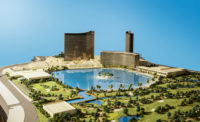Natural Appeal
Geology and geography provide southern Nevada with unique advantages for construction of data centers as companies look to tap the data center and cloud server markets.
“A convenient location, low risk of natural disasters and reasonably priced power make Las Vegas an appealing destination,” says Don Rodie, a Phoenix-based broker for Cushman & Wakefield and part of the real estate company’s national advisory group on data center projects.
Developers can take advantage of depressed land prices around Las Vegas, and, more importantly when building electricity-hungry data centers, Nevada’s power rates are below national average and much less expensive than in neighboring California.
"Data centers are driven by the cost of electricity more than the cost of land or the cost of real estate,” says Judy Caruthers, the Century City, Calif.-based Southwest regional manager for Jones Lang LaSalle commercial real estate.
Still, building in the dusty Mojave Desert makes the already rigorous process of developing a data center even trickier.
“The first major challenge is physically getting enough cooling capacity into the space,” says Travis Schultz, project manager with Las Vegas-based Burke Construction Group Inc., the general contractor the Cobalt project. “With the high power demand that these facilities are designed for, it requires an extreme amount of cooling with little room for error or failure. Special considerations have to be made to ensure that the facility is utilizing outside air as much as possible. In the desert we have to go one step further by adding the ability to close the outside air dampers at a moment’s notice due to the high potential of dust storms that could pollute the air quality within the data center.”
Managed service provider ViaWest, Greenwood Village, Colo., recently opened a 110,000 sq ft facility in North Las Vegas that earned the Uptime Institute's Tier IV design certification. The designation certifies that, when built to design specifications, the facility is fault-tolerant and capable of withstanding fire, explosion and loss of electricity or cooling systems without any impact to its IT equipment.
The facility is also the most energy efficient of the company’s 24 data centers, three of which are in the Las Vegas area.
“Many people think that cooling a data center in a hot desert is inefficient,” says Dave Leonard, ViaWest senior vice president of data center operations. “However, the Lone Mountain data center [in North Las Vegas] uses indirect evaporation for cooling, and evaporation works great in the dry desert air.”
Leonard says ViaWest plans “to continue to expand our data center footprint in the Las Vegas area.”




Post a comment to this article
Report Abusive Comment